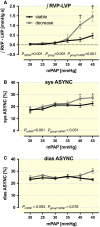Adaptation to acute pulmonary hypertension in pigs
- PMID: 29512293
- PMCID: PMC5840392
- DOI: 10.14814/phy2.13605
Adaptation to acute pulmonary hypertension in pigs
Abstract
The extent of right ventricular compensation compared to the left ventricle is restricted and varies among individuals, which makes it difficult to define. While establishing a model of acute pulmonary hypertension in pigs we observed two different kinds of compensation in our animals. Looking deeper into the hemodynamic data we tried to delineate why some animals could compensate and others could not. Pulmonary hypertension (mean pressure 45 mmHg) was induced gradually by infusion of a stable thromboxane A2 analogue U46619 in a porcine model (n = 22). Hemodynamic data (pressure-volume loops, strain-analysis of echocardiographic data and coronary flow measurements) were evaluated retrospectively for the short-term right ventricular compensatory mechanisms and limits (Roehl et al. [2012] Acta Anaesthesiol. Scand., 56:449-58) 10 animals showed stable arterial blood pressures, whereas 12 pigs exhibited a significant drop of 16.4 ± 9.9 mmHg. Cardiac output and heart rate were comparable in both groups. In contrast, right ventricular contractility and coronary flow only rose in the stable group. The unchanging values in the decrease group correlated with an increasing ST-segment depression and a loss of ventricular synchronism and resulted in a larger septum bulging to the right ventricle. Simultaneously, a reduced left-ventricular end-diastolic volume and a missing improvement in contractility in the posterior septal and inferior free wall of the left ventricle have been observed. Our findings suggest that right ventricular compensation during acute pulmonary hypertension is strongly dependent on the individual capability to increase coronary flow. The cause for inter-individual variability could be the dimension and reactivity of the coronary system.
Keywords: Coronary circulation; myocardial contraction; physiological adaptation; pulmonary hypertension; right; swine; ventricular dysfunction.
© 2018 The Authors. Physiological Reports published by Wiley Periodicals, Inc. on behalf of The Physiological Society and the American Physiological Society.
Figures





References
-
- Ama, R. , Leather H. A., Segers P., Vandermeersch E., and Wouters P. F.. 2006. Acute pulmonary hypertension causes depression of left ventricular contractility and relaxation. Eur. J. Anaesthesiol. 23:824–831. - PubMed
-
- Baan, J. , van der Velde E. T., de Bruin H. G., Smeenk G. J., Koops J., van Dijk A. D., et al. 1984. Continuous measurement of left ventricular volume in animals and humans by conductance catheter. Circulation 70:812–823. - PubMed
-
- Belenkie, I. , Horne S. G., Dani R., Smith E. R., and Tyberg J. V.. 1995. Effects of aortic constriction during experimental acute right ventricular pressure loading. Further insights into diastolic and systolic ventricular interaction. Circulation 92:546–554. - PubMed
-
- Benyo, Z. , Kiss G., Szabo C., Csaki C., and Kovach A. G.. 1991. Importance of basal nitric oxide synthesis in regulation of myocardial blood flow. Cardiovasc. Res. 25:700–703. - PubMed
-
- Bernstein, R. D. , Ochoa F. Y., Xu X., Forfia P., Shen W., Thompson C. I., et al. 1996. Function and production of nitric oxide in the coronary circulation of the conscious dog during exercise. Circ. Res. 79:840–848. - PubMed
Publication types
MeSH terms
Substances
LinkOut - more resources
Full Text Sources
Other Literature Sources
Medical

